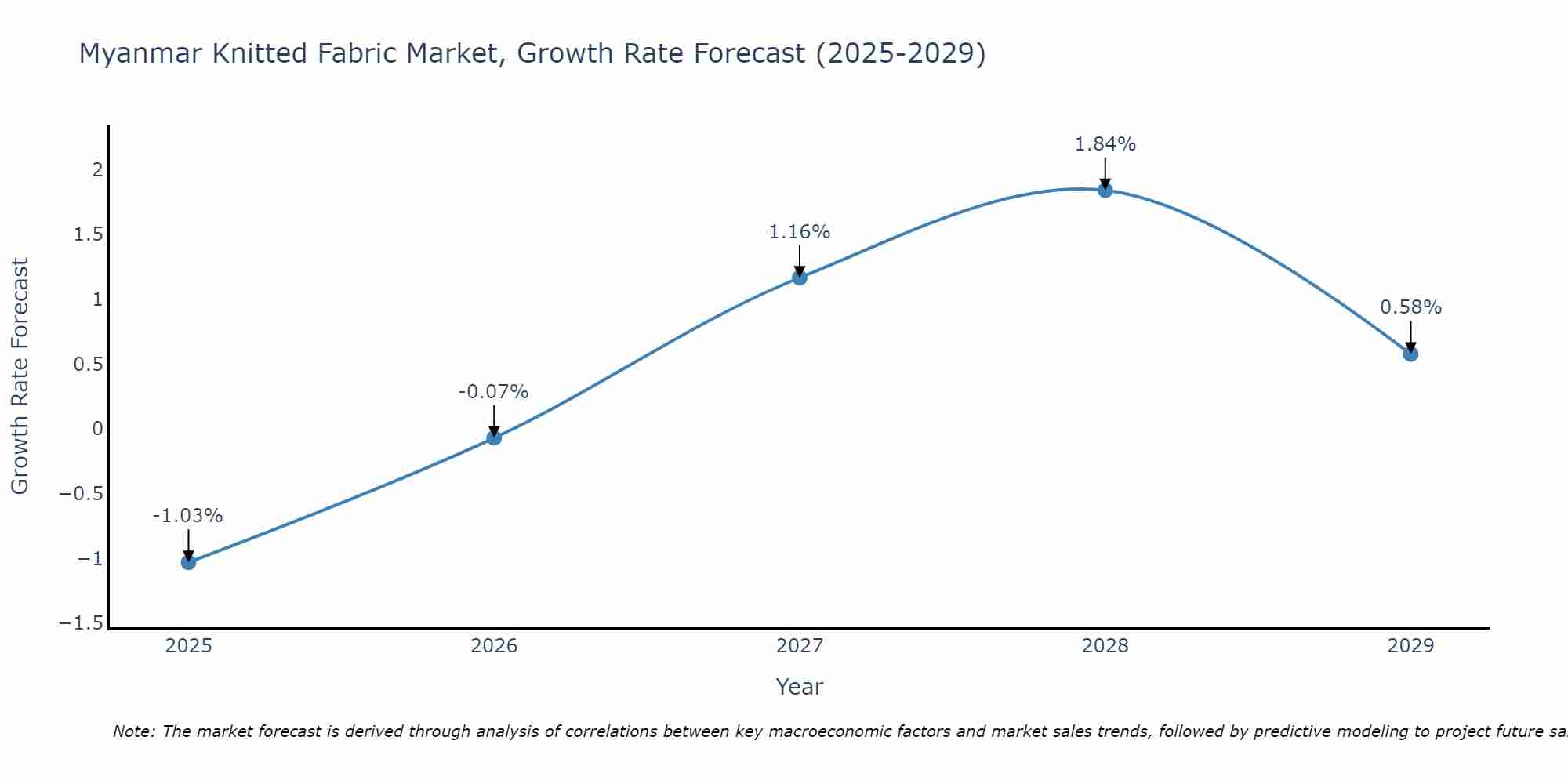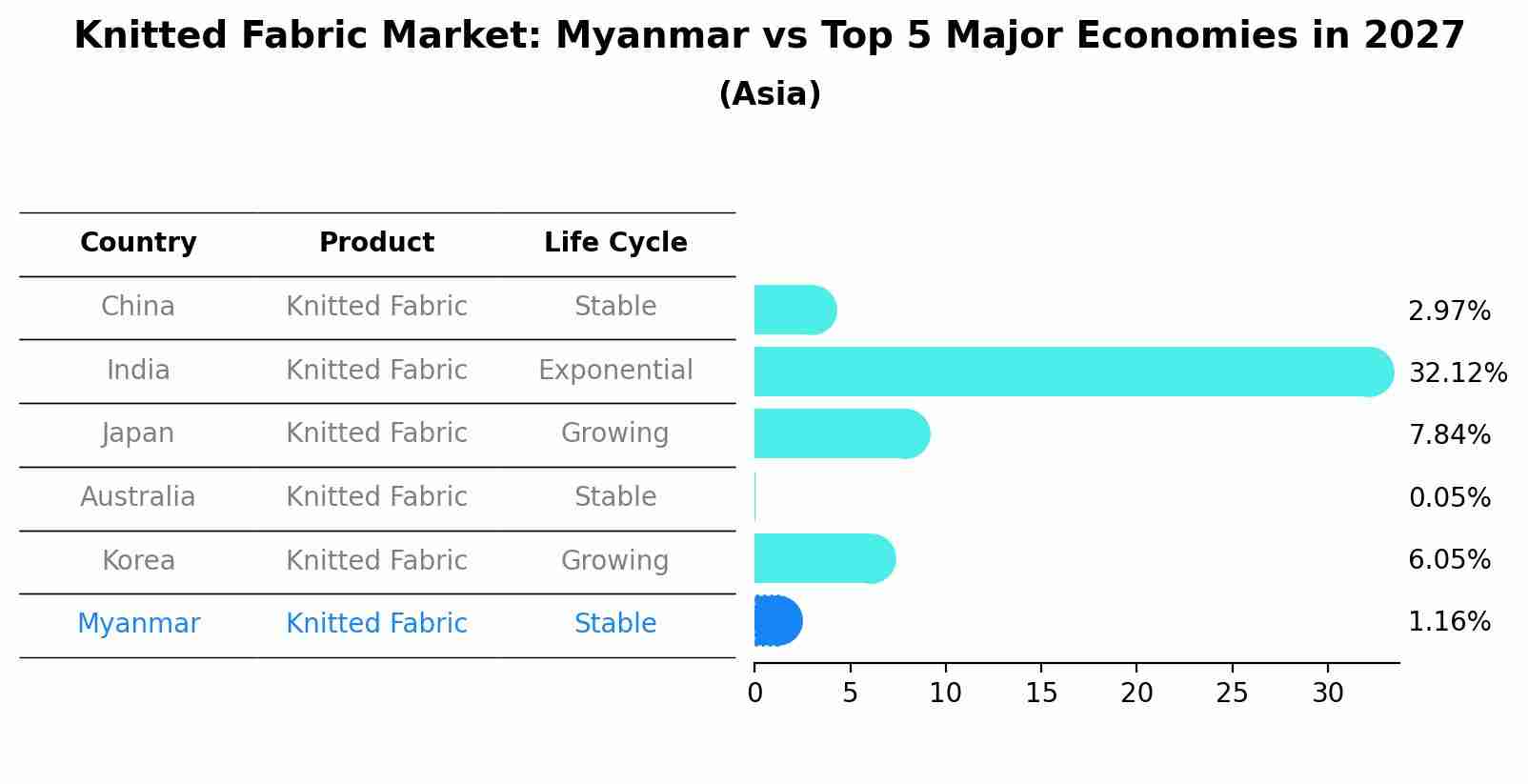Myanmar Knitted Fabric Market (2025-2031) | Outlook, Growth, Revenue, Analysis, Trends, Companies, Size, Share, Forecast, Value & Industry
| Product Code: ETC036414 | Publication Date: Oct 2020 | Updated Date: Jun 2025 | Product Type: Report | |
| Publisher: 6Wresearch | Author: Shubham Padhi | No. of Pages: 70 | No. of Figures: 35 | No. of Tables: 5 |
Myanmar Knitted Fabric Market Size Growth Rate
The Myanmar Knitted Fabric Market is projected to witness mixed growth rate patterns during 2025 to 2029. Growth accelerates to 1.84% in 2028, following an initial rate of -1.03%, before easing to 0.58% at the end of the period.

Knitted Fabric Market: Myanmar vs Top 5 Major Economies in 2027 (Asia)
Myanmar's Knitted Fabric market is anticipated to experience a stable growth rate of 1.16% by 2027, reflecting trends observed in the largest economy China, followed by India, Japan, Australia and South Korea.

Myanmar Knitted Fabric Market Overview
The Myanmar knitted fabric market is experiencing steady growth driven by factors such as increasing demand for comfortable and versatile clothing options, as well as the rise of the country`s garment manufacturing industry. The market offers a wide range of knitted fabrics including cotton, polyester, and blends, catering to various consumer preferences. Key players in the industry are focusing on product innovation, sustainability, and efficient production processes to stay competitive. The market also benefits from Myanmar`s strategic location for exports to neighboring countries and favorable trade agreements. However, challenges such as limited infrastructure, skilled labor shortages, and fluctuating raw material prices pose constraints to market growth. Overall, the Myanmar knitted fabric market presents opportunities for both domestic and international players looking to capitalize on the country`s growing textile industry.
Myanmar Knitted Fabric Market Trends
The Myanmar Knitted Fabric Market is experiencing a growth trend driven by increasing demand for comfortable and versatile clothing. Consumers are showing a preference for knitted fabrics due to their soft texture, stretchability, and breathability. The market is also benefiting from the rising popularity of athleisure wear and casual apparel, which often incorporate knitted fabrics for their comfort and performance properties. Additionally, sustainability and eco-friendly materials are becoming increasingly important, leading to a growing interest in organic and recycled knitted fabrics. Manufacturers in Myanmar are responding to these trends by expanding their product offerings to include a wider range of knitted fabric options, such as bamboo, modal, and Tencel, to cater to evolving consumer preferences.
Myanmar Knitted Fabric Market Challenges
The Myanmar Knitted Fabric Market faces several challenges, including a lack of advanced technology and machinery, limited access to quality raw materials, inconsistent supply chain logistics, and intense competition from neighboring countries with lower production costs. Additionally, the industry is hindered by inadequate infrastructure, unreliable electricity supply, and limited skilled labor. Political instability and regulatory uncertainties also pose risks to the market`s growth and development. Overall, these challenges combined make it difficult for businesses in the Myanmar Knitted Fabric Market to compete effectively on a global scale and hinder their ability to achieve sustainable growth and profitability.
Myanmar Knitted Fabric Market Investment Opportunities
The Myanmar Knitted Fabric Market presents promising investment opportunities due to the country`s growing garment industry and increasing demand for high-quality textiles. With a focus on sustainability and ethical production practices becoming more important in the global market, investing in the production and distribution of eco-friendly knitted fabrics could be particularly lucrative. Additionally, Myanmar`s strategic location between major textile manufacturing hubs like China and India provides a competitive advantage for exporting to international markets. Investing in modernizing production facilities, improving supply chain efficiency, and developing innovative textile products could position investors well to capitalize on the growing demand for knitted fabrics in Myanmar and beyond.
Myanmar Knitted Fabric Market Government Policy
Government policies related to the Myanmar Knitted Fabric Market include the Myanmar Investment Law, which allows foreign investors to set up manufacturing facilities in designated zones, providing opportunities for growth in the textile industry. Additionally, the government has implemented various trade agreements to facilitate exports and imports of knitted fabrics, promoting international trade. The Myanmar Garment Manufacturers Association works closely with the government to address industry challenges and promote the growth of the knitted fabric market. Overall, government policies aim to attract investments, promote exports, and create a conducive environment for the development of the knitted fabric industry in Myanmar.
Myanmar Knitted Fabric Market Future Outlook
The Myanmar knitted fabric market is expected to demonstrate steady growth in the upcoming years. Factors such as increasing demand for comfortable and fashionable clothing, rising disposable income levels, and a growing textile industry in Myanmar are likely to drive the market expansion. Additionally, the country`s strategic location and favorable trade agreements could further boost the export opportunities for knitted fabrics. The market is also witnessing advancements in technology and sustainability practices, which are anticipated to attract more investments and enhance product offerings. However, challenges such as infrastructure limitations and competition from established textile markets may pose some hurdles. Overall, with the right strategies and investments, the Myanmar knitted fabric market holds promising prospects for future growth and development.
Key Highlights of the Report:
- Myanmar Knitted Fabric Market Outlook
- Market Size of Myanmar Knitted Fabric Market, 2024
- Forecast of Myanmar Knitted Fabric Market, 2026
- Historical Data and Forecast of Myanmar Knitted Fabric Revenues & Volume for the Period 2021 - 2031
- Myanmar Knitted Fabric Market Trend Evolution
- Myanmar Knitted Fabric Market Drivers and Challenges
- Myanmar Knitted Fabric Price Trends
- Myanmar Knitted Fabric Porter's Five Forces
- Myanmar Knitted Fabric Industry Life Cycle
- Historical Data and Forecast of Myanmar Knitted Fabric Market Revenues & Volume By Construction Type for the Period 2021 - 2031
- Historical Data and Forecast of Myanmar Knitted Fabric Market Revenues & Volume By Weft for the Period 2021 - 2031
- Historical Data and Forecast of Myanmar Knitted Fabric Market Revenues & Volume By Wrap for the Period 2021 - 2031
- Historical Data and Forecast of Myanmar Knitted Fabric Market Revenues & Volume By Fabrics Type for the Period 2021 - 2031
- Historical Data and Forecast of Myanmar Knitted Fabric Market Revenues & Volume By Flat/Jersey for the Period 2021 - 2031
- Historical Data and Forecast of Myanmar Knitted Fabric Market Revenues & Volume By Purl for the Period 2021 - 2031
- Historical Data and Forecast of Myanmar Knitted Fabric Market Revenues & Volume By Rib Stitch for the Period 2021 - 2031
- Historical Data and Forecast of Myanmar Knitted Fabric Market Revenues & Volume By Interlock for the Period 2021 - 2031
- Myanmar Knitted Fabric Import Export Trade Statistics
- Market Opportunity Assessment By Construction Type
- Market Opportunity Assessment By Fabrics Type
- Myanmar Knitted Fabric Top Companies Market Share
- Myanmar Knitted Fabric Competitive Benchmarking By Technical and Operational Parameters
- Myanmar Knitted Fabric Company Profiles
- Myanmar Knitted Fabric Key Strategic Recommendations
Frequently Asked Questions About the Market Study (FAQs):
1 Executive Summary |
2 Introduction |
2.1 Key Highlights of the Report |
2.2 Report Description |
2.3 Market Scope & Segmentation |
2.4 Research Methodology |
2.5 Assumptions |
3 Myanmar Knitted Fabric Market Overview |
3.1 Myanmar Country Macro Economic Indicators |
3.2 Myanmar Knitted Fabric Market Revenues & Volume, 2019 & 2026F |
3.3 Myanmar Knitted Fabric Market - Industry Life Cycle |
3.4 Myanmar Knitted Fabric Market - Porter's Five Forces |
3.5 Myanmar Knitted Fabric Market Revenues & Volume Share, By Construction Type, 2019 & 2026F |
3.6 Myanmar Knitted Fabric Market Revenues & Volume Share, By Fabrics Type, 2019 & 2026F |
4 Myanmar Knitted Fabric Market Dynamics |
4.1 Impact Analysis |
4.2 Market Drivers |
4.3 Market Restraints |
5 Myanmar Knitted Fabric Market Trends |
6 Myanmar Knitted Fabric Market, By Types |
6.1 Myanmar Knitted Fabric Market, By Construction Type |
6.1.1 Overview and Analysis |
6.1.2 Myanmar Knitted Fabric Market Revenues & Volume, By Construction Type, 2016 - 2026F |
6.1.3 Myanmar Knitted Fabric Market Revenues & Volume, By Weft , 2016 - 2026F |
6.1.4 Myanmar Knitted Fabric Market Revenues & Volume, By Wrap, 2016 - 2026F |
6.2 Myanmar Knitted Fabric Market, By Fabrics Type |
6.2.1 Overview and Analysis |
6.2.2 Myanmar Knitted Fabric Market Revenues & Volume, By Flat/Jersey, 2016 - 2026F |
6.2.3 Myanmar Knitted Fabric Market Revenues & Volume, By Purl , 2016 - 2026F |
6.2.4 Myanmar Knitted Fabric Market Revenues & Volume, By Rib Stitch, 2016 - 2026F |
6.2.5 Myanmar Knitted Fabric Market Revenues & Volume, By Interlock , 2016 - 2026F |
7 Myanmar Knitted Fabric Market Import-Export Trade Statistics |
7.1 Myanmar Knitted Fabric Market Export to Major Countries |
7.2 Myanmar Knitted Fabric Market Imports from Major Countries |
8 Myanmar Knitted Fabric Market Key Performance Indicators |
9 Myanmar Knitted Fabric Market - Opportunity Assessment |
9.1 Myanmar Knitted Fabric Market Opportunity Assessment, By Construction Type, 2019 & 2026F |
9.2 Myanmar Knitted Fabric Market Opportunity Assessment, By Fabrics Type, 2019 & 2026F |
10 Myanmar Knitted Fabric Market - Competitive Landscape |
10.1 Myanmar Knitted Fabric Market Revenue Share, By Companies, 2024 |
10.2 Myanmar Knitted Fabric Market Competitive Benchmarking, By Operating and Technical Parameters |
11 Company Profiles |
12 Recommendations |
13 Disclaimer |
- Single User License$ 1,995
- Department License$ 2,400
- Site License$ 3,120
- Global License$ 3,795
Search
Thought Leadership and Analyst Meet
Our Clients
Related Reports
- Canada Oil and Gas Market (2026-2032) | Share, Segmentation, Value, Industry, Trends, Forecast, Analysis, Size & Revenue, Growth, Competitive Landscape, Outlook, Companies
- Germany Breakfast Food Market (2026-2032) | Industry, Share, Growth, Size, Companies, Value, Analysis, Revenue, Trends, Forecast & Outlook
- Australia Briquette Market (2025-2031) | Growth, Size, Revenue, Forecast, Analysis, Trends, Value, Share, Industry & Companies
- Vietnam System Integrator Market (2025-2031) | Size, Companies, Analysis, Industry, Value, Forecast, Growth, Trends, Revenue & Share
- ASEAN and Thailand Brain Health Supplements Market (2025-2031) | Strategy, Consumer Insights, Analysis, Investment Trends, Opportunities, Growth, Size, Share, Industry, Revenue, Segments, Value, Segmentation, Supply, Forecast, Restraints, Outlook, Competition, Drivers, Trends, Demand, Pricing Analysis, Competitive, Strategic Insights, Companies, Challenges
- ASEAN Bearings Market (2025-2031) | Strategy, Consumer Insights, Analysis, Investment Trends, Opportunities, Growth, Size, Share, Industry, Revenue, Segments, Value, Segmentation, Supply, Forecast, Restraints, Outlook, Competition, Drivers, Trends, Demand, Pricing Analysis, Competitive, Strategic Insights, Companies, Challenges
- Europe Flooring Market (2025-2031) | Outlook, Share, Industry, Trends, Forecast, Companies, Revenue, Size, Analysis, Growth & Value
- Saudi Arabia Manlift Market (2025-2031) | Outlook, Size, Growth, Trends, Companies, Industry, Revenue, Value, Share, Forecast & Analysis
- Uganda Excavator, Crane, and Wheel Loaders Market (2025-2031) | Strategy, Consumer Insights, Analysis, Investment Trends, Opportunities, Growth, Size, Share, Industry, Revenue, Segments, Value, Segmentation, Supply, Forecast, Restraints, Outlook, Competition, Drivers, Trends, Demand, Pricing Analysis, Competitive, Strategic Insights, Companies, Challenges
- Rwanda Excavator, Crane, and Wheel Loaders Market (2025-2031) | Strategy, Consumer Insights, Analysis, Investment Trends, Opportunities, Growth, Size, Share, Industry, Revenue, Segments, Value, Segmentation, Supply, Forecast, Restraints, Outlook, Competition, Drivers, Trends, Demand, Pricing Analysis, Competitive, Strategic Insights, Companies, Challenges
Industry Events and Analyst Meet
Whitepaper
- Middle East & Africa Commercial Security Market Click here to view more.
- Middle East & Africa Fire Safety Systems & Equipment Market Click here to view more.
- GCC Drone Market Click here to view more.
- Middle East Lighting Fixture Market Click here to view more.
- GCC Physical & Perimeter Security Market Click here to view more.
6WResearch In News
- Doha a strategic location for EV manufacturing hub: IPA Qatar
- Demand for luxury TVs surging in the GCC, says Samsung
- Empowering Growth: The Thriving Journey of Bangladesh’s Cable Industry
- Demand for luxury TVs surging in the GCC, says Samsung
- Video call with a traditional healer? Once unthinkable, it’s now common in South Africa
- Intelligent Buildings To Smooth GCC’s Path To Net Zero


















